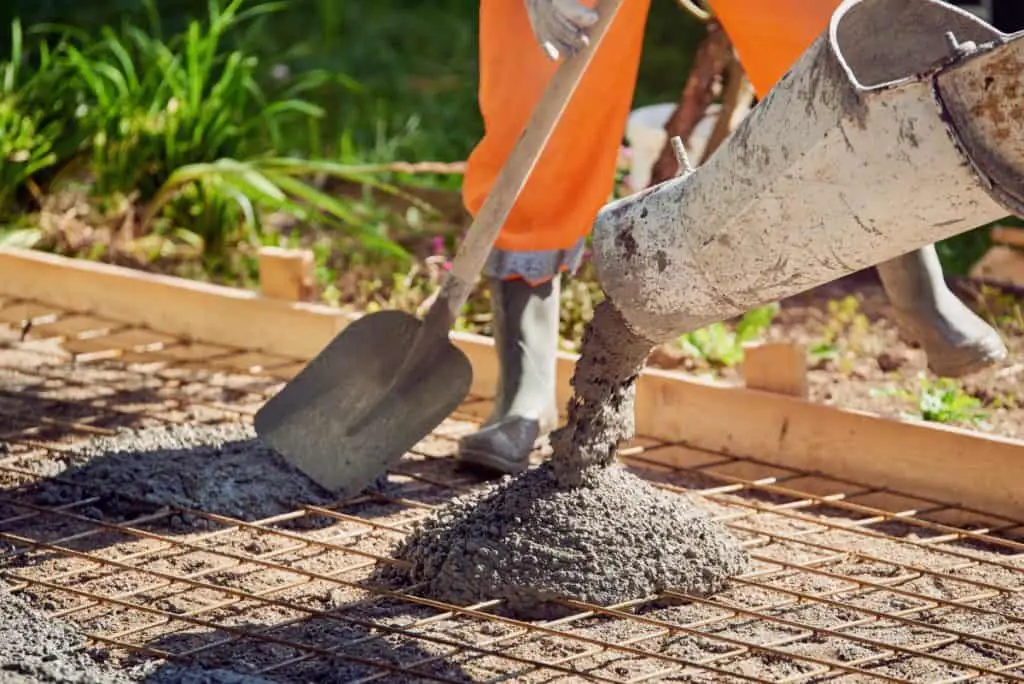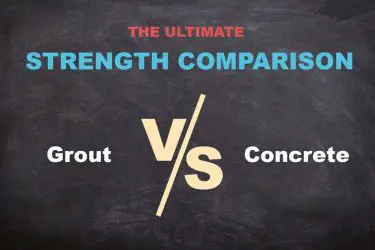You may have heard that some concrete professionals add rebar into concrete to increase the concrete’s strength. This does happen, but not as often as you might think. If you’re thinking of starting a project at home, such as pouring concrete for your driveway or a patio, chances are you won’t need rebar at all.
Add rebar to strengthen concrete under certain conditions:
- The subbase on which you pour the concrete is not ideal
- The concrete will have constant traffic such as a city street
- The concrete will need to support a lot of extreme weight
- The contraction joints are spaced more than 15 feet apart
But before you rush to purchase rebar for your particular project, there are a few important to consider. Besides the fact that a garage or driveway might not even need rebar, there are things you can check to be sure.

Table of Contents
Rebar Or Mesh?
Rebar is short for reinforcing bar and is also known as reinforcing or reinforcement steel. All rebar is steel and is used especially in concrete or masonry projects to add strength to concrete. It is typically used in larger projects where lots of concrete needs lots of strength to keep it from cracking or breaking apart.
On the other hand, wire mesh (also called reinforced welded wire mesh, or sometimes “remesh”) is a sheet-like material formed into a grid-like pattern that is added to concrete to help support concrete, much like rebar. It is made out of galvanized stainless steel wires. Mesh is not as strong as rebar since the wires are not as thick. It is an option, however, when considering how large your project is and how much reinforcement the concrete needs.

Rebar is designed to prevent structural or foundational cracking while wire mesh is designed to prevent cracking in smaller projects and not suited for a heavyweight, for example, in the foundation of a large building.
Rebar commonly comes in 10 to 12mm thickness while remesh comes in 4mm thickness. In terms of cost, rebar tends to cost more than 5x the price of wire mesh. In one comparison, the minimum cost for wire mesh is $0.14 per square foot while rebar’s minimum cost is $0.75 per square foot. Source
Also read: What Concrete Requires No Reinforcement?
Types Of Rebar
- Tempered Steel Rebar: Also known as “carbon steel” rebar or “black bar,” this is the most common type of rebar out there. It, unfortunately, corrodes easily compared to other rebars.
- European Rebar: This is a cheap type of rebar made from manganese. It doesn’t withstand extreme conditions, and shouldn’t be used where stronger rebar is available.
- Epoxy-Coated Rebar: Also known as “green bar” and is used mainly in bridges, or humid environments since it is very resistant to corrosion.
- Galvanized Rebar: This rebar is also very resistant to corrosion, much like the epoxy-coated rebar, but it is more expensive.
- Stainless Steel Rebar: This is the most expensive rebar, but it’s also very strong and resistant to corrosion.
- Glass-Fiber-Reinforced- Polymer: Also called “fiberglass rebar.” this is made of a resin wrapped with fiberglass that has higher tensile strength than steel, will never corrode, and is very expensive.

Some rebar comes as “deformed” versus “plain.” Deformed means they have ridges in their structure that help with reinforcing the concrete. Plain rebar obviously doesn’t have the ridges and is used when the steel must “slide,” such as in bridges or highways.
There are different sizes of rebar also, and each size has a number. In the United States, we use the imperial bar size (i.e. #3 or #4) instead of the “soft” metric sizing (ie. #10 or #13).
| Imperial Bar Size | Metric Measurement (millimeter) |
| #3 | 10 |
| #4 | 13 |
| #5 | 16 |
| #6 | 19 |
| #7 | 22 |
| #8 | 25 |
| #9 | 29 |
| #10 | 32 |
| #11 | 36 |
| #14 | 43 |
| #18 | 57 |
Compressive VS Tensile Strength
A concrete’s compressive strength is the resistance to breaking under compression after it has set and cured. This is usually measured in megapascals (MPa) or pounds per square inch (psi) and each concrete mixture will have a different compressive strength depending on how the manufacturer designed it.

Most concrete’s compressive strength varies between 2500 psi (17 MPa) and 5000 psi (34.5 MPa), and only after it has sat and cured properly after 28 days (or 1 month). This strength increases over time as water is added and reacts to the chemicals in the mixture.
However strong the concrete is, its tensile strength is approximately 1/10th of that value. For concrete that is between 3000 to 6000 psi (or 20 to 40 MPa), then its tensile strength would be 300 to 700 psi (or 4 to 5 MPa). This is why concrete tends to crack over time.
Concrete professionals add rebar or mesh to concrete in order to increase the tensile strength of the concrete and prevent cracking that could, for example, ruin or destroy the foundation of a building. Multi-story parking garages are a great example of a large concrete structure that cannot do without rebar to amplify its tensile strength.
It’s important to note, however, that garages and driveways don’t necessarily need reinforcement since the heaviest vehicle that sits on the concrete might be a minivan or a truck. Concrete may crack over time anyway, but there are other cheaper methods to use to fix cracks caused by time.
Read more: Fixing Cracks in the Driveway: A Cost Breakdown
The Subbase
The subbase is the layer of material that is placed underneath the concrete before it is poured to act as a foundation for the concrete slab. For projects such as patios or driveways, the subbase is one of the most important factors to consider before adding rebar or remesh to the concrete.
Materials used in the subbase tend to be course gravel that allows for water to drain from the concrete. Beneath the subbase is the native soil, sometimes called the “sub-ground” or “subgrade,” that has been compacted and leveled before the subbase is poured on.

The quality of the subbase can determine the strength and lifespan of the concrete that’s poured on top of it. If the subgrade is not firm or has pockets of spongy dirt, then you may need to add rebar to the concrete in order to strengthen the foundation.
While subbases are optional additions to concrete projects, all subbases should offer uniform support for the concrete. The thicker the subbase, the more the concrete can hold. For walkways or patios, gravel is an excellent material to use for the subbase to prevent cracking or shifting concrete.
Using Contraction Joints
Concrete contraction joints are essential “cracks” that are purposefully embedded into the concrete to compensate when the concrete shrinks or expands with the atmospheric temperature. This may seem counterintuitive, but contraction joints are weak areas in the concrete that have been planned.

These planned weak spots can usually control where cracks will inevitably happen in the concrete. Professionals will create straight lines in the concrete a specific distance apart. Usually, these distances are 24 to 30 times the thickness of the slab. The result is an aesthetically pleasing look that allows the cracks to form along the joints, usually in straight lines =.
However, in some cases where contraction joints aren’t used or when they’re more than 15-feet apart from each other, it can expose the surface of the concrete to random cracking. As you plan to pour the concrete, take this into account as well. Because if you do not plan to include the joints in the concrete, then rebar might be the best option to help prevent cracking and shrinking.
The Thickness Of Concrete
The recommended minimum thickness for when you pour cement for any project is 4-inches. This is especially true if you’re pouring for a sidewalk, a driveway, or a garage floor.
Read more: Concrete Thickness for a Garage: 9 Things to Consider
In cases where 4 inches of concrete is enough, rebar or any other type of reinforcing material is normally not necessary. However, as with most things in life, there may be extenuating circumstances where rebar is required. In general, 4-inches of concrete is too low if you are planning to add rebar.

In this hypothetical case, using at least 6 or 8 inches of concrete would be ideal. The reason for this is because rebar should be placed between 1/2- and 3-inches down from the concrete surface at the very least. This is also called how much embedment or “cover” the reinforcement needs in the concrete.
The Positioning Of The Rebar
There are a few conditions to consider how much cover the rebar needs before setting the rebar. Just putting the rebar in and pouring the concrete isn’t enough. The rebar needs to be stable and held tight so that it doesn’t move around later.
- If your concrete is being poured against exposed soil without any gravel subbase, then the cover should be a minimum of 3-inches.
- If your concrete will be exposed to weather or soil, then a #6 bar or larger will need 2-inches of cover. #5 bars or smaller will need 1 1/2-inches.
- If concrete is not exposed to weather or soil (typically #14 and #18 rebars) then 1/2-inch is enough to cover. For #11 bars and smaller, then it needs a 3/4-inch cover.
Each project will be different and individual to your situation. As with all projects you undertake with concrete, if you are unsure whether you need reinforcement in your concrete, it’s always best to consult a contractor or a professional with any questions you may have.



